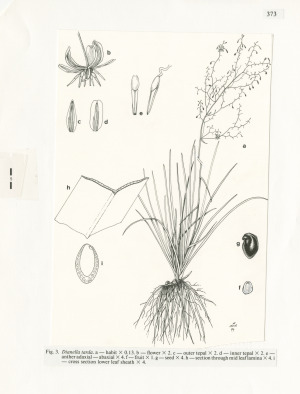Dianella tarda
P.F.Horsfall & G.W.CarrSlender to robust tufted plants, the tufts sometimes aggregated via short rhizomes to form clumps to c. 20 cm diam.; flowering stems erect, to c. 2 m high. Leaves not or hardly sheathing at base, more or less erect, 35–150 cm long, 6–15 mm wide, usually strongly V-shaped in section, green to slightly glaucous, concolorous, smooth along margins and abaxial midrib, or midrib irregularly scabrous toward leaf tip. Inflorescence distinctly exceeding foliage; panicle c. ovoid, sparse throughout to moderately dense above; pedicels recurved, 4–22 mm long; flowers 15–18 mm wide, pale blue; perianth segments slightly to strongly recurved, 7–9 mm long; stamens 7–9 mm long, filaments 2–3 mm long, kinked, filament swellings (strumae) rich yellow, c. 1. 5 mm long, shorter than the pale yellow c. 4 mm long anthers. Berry irregularly globular, 3–10 mm long and wide, pale blue or sometimes nearly white; seeds flattened ellipsoid, 2.5–3.5 mm long, smooth, black and glossy. Flowers Nov.–Jan.
MuM, Wim, VVP, VRiv, MuF, Gold, CVU, NIS, HNF. Occurs also N.S.W. Open, often grassy forests of foothills and plains of north-eastern and north-central Victoria (e.g. Mansfield, Euroa, Chiltern, Nagambie, Nathalia areas). Often on lower slopes or near gullies and watercourses, usually on clay or clay-loam soils.
Distinguished by its (usually) tall inflorescence, and narrow, strongly channelled leaves. The flowers are reported to be open from early afternoon to late evening, later than other members of the D. longifolia group in Victoria (D. amoena, D. longifolia, D. porracea) which are generally collapsed by mid-afternoon.
 Spinning
Spinning

